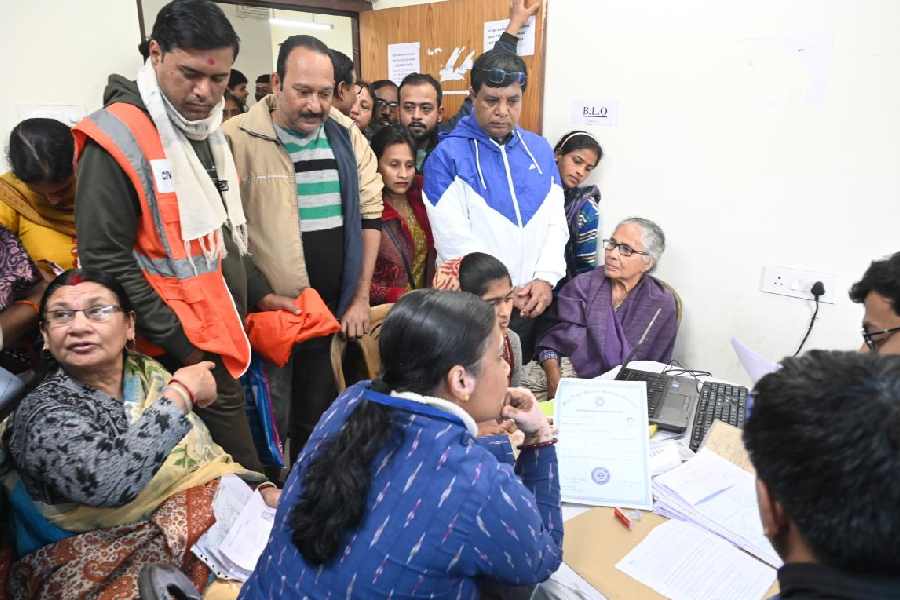 |
| The hull of the IAC-1 being built at Kochi |
Aug. 5: Defence scientists, the Indian Navy and the Steel Authority of India have claimed that they have developed a special grade of steel that will replace imports worth billions of dollars that were so far being used to make dozens of warships.
The special steel is military-grade, far hardier and lasting and capable of being used in temperatures as low as — 40°C — and of absorbing great ballistic impact — than the metal that went into the making of the Titanic or that goes into the making of ordinary kitchen utensils found in every Indian home.
“The steel that we have developed is both hard and tough — the hardness will not allow it to break but the toughness will allow it to be bent,” said technologist P.K. Dutta of Bhilai’s research and development unit who worked on the project with DRDO’s distinguished scientist G. Malkondaiah and the directorate of naval design.
The breakthrough is the outcome of a technology denial regime and forex crunch as well as a spin-off from the ambitious project to make India’s single largest military platform — a 42,000-tonne Indigenous Aircraft Carrier. “Necessity is the mother of invention,” is the proverb quoted repeatedly by officials at the facilities where the steel is being produced and in the navy.
SAIL has so far delivered about 28,000 tonnes of the warship-grade steel for the Indigenous Aircraft Carrier-1, called Project 71 (P-71), which is scheduled to take to the water on August 12 (next Monday) in Kochi. Taking to the water means that the ship will float but it is still at least five years from being commissioned into the fleet.
Public sector SAIL has set up exclusive facilities at a Special Plates Plant (SPP) in Rourkela that was shown to a small group of journalists for the first time during a conducted tour last weekend.
(Till now unknown outside a charmed circle, the visit to the SPP also gave a glimpse into production lines for armoured plates for Russian-origin T-72 and T-90 tanks, the indigenous main battle tank Arjun and for mine-protected vehicles used in counter-insurgency operations. The SPP is being expanded from a capacity to produce 2,000 tonnes to make 12,000 tonnes of special steel.)
A team of scientists of the Defence Metallurgical Research Laboratory (DMRL) worked with technologists to develop and set up a production line of the steel, called DMR249A at the Bhilai plant over the last seven years.
Another variant of the steel, called DMR249B, was made at the Alloy Steel Plant (ASP) in Durgapur. This grade is also being used to repair the Indian Navy’s Russian-origin Kilo-class submarines and is slated for use in another line of submarines. This grade of steel has also been used to build anti-submarine warfare corvette, the INS Kamorta, at Calcutta’s Garden Reach Shipbuilders and Engineers, a defence public sector unit.
The process for the special steel was established in Bhilai after successive “melts” in three plants. While the chemistry of the military-grade steel is a state secret, its peculiar characteristics are said to be a composition of elements chromium, nickel, neobium, vanadium and molybdenum (among others) added to iron ore, coke and coal that go into the making of ordinary steel.
SAIL officials claim that while the special steel is twice the price of other grades of the industrial-purpose metal, it is half the cost of the imported variety that is used in warships. The steel, says Commodore Saibal Sen, project director of P-71, “was a technological imperative”. In any case, countries that produce the steel were either unwilling or unable to continue selling it to India.
The special steel will be used to make all Indian warships — and to repair its vessels — from now on, said Commodore A.K. Dutta, principal director in the directorate of naval architecture. The navy now has 46 warships on order.
“We are setting up expanded facilities (in Rourkela) and I hope that the navy will continue to patronise us,” said SAIL chairperson C.S. Verma.
Inquiries revealed the process has taken about 10 years. In 1999, the navy procured the formula for a grade of the metal called ABA steel from Russia. The navy was using the metal for its warships — many of which were and are on order in Russia. The navy then handed it over to the DMRL.
“That gave us the chemistry but it did not tell us how we can produce it,” says Malkondaiah.
Recalls P.K. Dutta of Bhilai: “One day Commodore (now retired) Sekoria (of the naval design directorate) told me we have to develop the process or the indigenous warship project will have to be abandoned altogether.”
The first experiments were undertaken by the National Metallurgical Research Laboratory (NMRL) and involved Heavy Engineering Corporation, Ranchi. But the experiments were a failure. Then the DRDO tasked the DMRL and SAIL till technologists at the Bhilai Steel Plant and the Alloy Steel Plant, Durgapur, discovered through trial and error that the properties of the ABA grade steel could be achieved through a “controlled rolling and continuous casting” process.
Subsequently, they also developed the quenching and tempering process to harden and toughen the steel in Rourkela. This involves dunking the plates cut and rolled from slabs of steel into large vessels of oil and water and re-heating them.
“Our research project worth about Rs 12 crore has now led to the supply of steel worth about Rs 600 crore,” claims Malkondaiah.
The technologists have further toughened the steel to produce another grade called DMR249z25. The “z25” is being used for the machine and engine chambers of the indigenous aircraft carrier.
Engineers say this steel can be “compressed” — meaning it can absorb so much impact — to 25 per cent of its thickness, giving it a shock-absorbing quality — such as that from a torpedo-hit. The team is now testing a more refined variety in Rourkela in a strategic project called the DMR292A exclusively for “underwater projects”, an euphemism for nuclear submarines.
India’s indigenous nuclear submarine, the INS Arihant, being built with Russian expertise, is due for “sea trials” off Visakhapatnam after its reactor goes “critical” — is able to power it fully — within the next fortnight. Two more similar submarines are also in the production line at Visakhapatnam’s Ship Building Centre.










